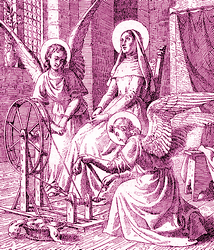Lives of the Saints
Our Models and Protectors
Spiritual Bouquet:
June 23

Saint Mary of Oignies
Recluse
(† 1213)
Mary of Oignies was born in the diocese of Liege in Belgium in 1167, of very wealthy parents. But while still very young, she rejected everything childish or vain — games, beautiful clothing, ornaments. At the age of fourteen, despite her desire to be a nun, she was obliged to marry a virtuous young lord. Her holy life caused admiration in her spouse and decided him to follow her examples; and together they resolved to practice continence for life, to distribute their wealth to the poor and consecrate themselves to works of piety. The demon tried every artifice to make them relent in their holy resolution, but failed. They drew down on themselves the most abundant blessings, as well as sarcasms and insults from the worldly.
Mary had the gift of tears, and could not look at a crucifix without breaking into a torrent of tears or being ravished in ecstasy. When a priest told her to cease these exhibitions, she asked God to make him understand that it is not possible for a creature to arrest tears which the Holy Spirit obliges to well up. And the priest, that same day while saying his Mass, began to shed so many tears that the altar cloths and his vestments were wet with them.
She had a great devotion to Saint John the Evangelist and conversed with him as well as with her Guardian Angel. By vision and revelation she often knew the temptations and secrets of the hearts of the persons who consulted her. She converted many, obtained graces by her prayers for the living and especially for the dead, for whom she offered prayers and sacrifices, and suffered various illnesses with invincible patience. Her many visitors made her life of contemplation difficult, and she decided to change her residence; her husband permitted her to go to Oignies, where she lived in retreat amidst her heavenly favors and conversations.
She saw the place destined for her in heaven, and gave up her holy soul surrounded by angelic songs of bliss. The faithful who have addressed her were so impressed with the value of her intercession that her relics became the object of great respect. Buried at Oignies, her remains in 1609 were placed in a silver reliquary in its parish church of Our Lady; in 1817 they were transferred to the Church of Saint Nicolas at Nivelle, near her birthplace.
Les Petits Bollandistes: Vies des Saints, by Msgr. Paul Guérin (Bloud et Barral: Paris, 1882), Vol. 7